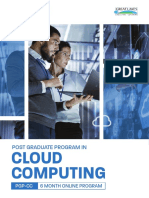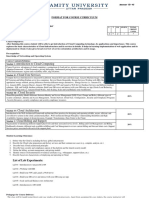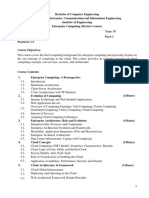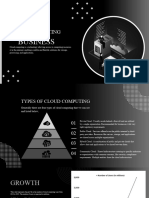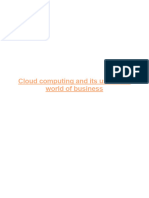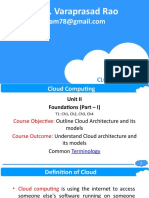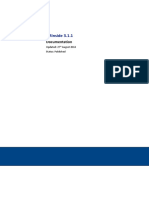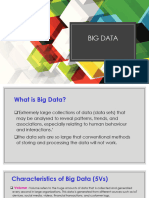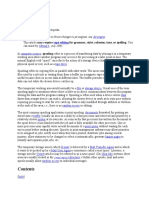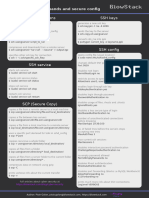FORE School of Management, New Delhi
Course Outline
Program: PGDM (FMG-30/IMG-15/FM-04/BDA-02)
Name of the Course: Managing Business on Cloud Credit: 3.0
Term: 4
Faculty: Prof. Shilpi Jain Academic Year: 2022-23
Office Contact No. 91-46485545 Email:shilpijain@fsm.ac.in
Introduction:
Cloud computing has changed the entire paradigm of conducting business. Cloud computing allows access
to the same kinds of applications through the internet, e.g. monetary transactions, social networking, video
streaming, gaming, etc. With the emergence of Start-up euphoria, the public cloud computing market has
grown to USD 495 billion in 2022. This encompasses business processes, platform, infrastructure, software,
management, security, and advertising services delivered by public cloud services. This market is expected
to expand at a Compound Annual Growth Rate (CAGR) of 14.9% from 2020 to 2027. All size organizations,
especially start-ups tend to set-up their business using cloud utilities as it offers almost nil CAPEX and
controlled OPEX. The cloud business models have evolved over 15 years and yet every other day we happen
to see an innovative product or service offered through the cloud. Future managers must distinguish cloud
offerings from conventional software products and services, as the future of the organizations lies on the
cloud.
The course is designed to prepare future managers with the nitty-gritty of setting up a business over cloud
such as planning, organizing, budgeting, implementing, pricing, contracting, and maintaining a cloud
business. How to market your business over the cloud and based on business dynamics, how to scale up or
down the infrastructure capabilities.
Objectives:
By the end of the course you will have a clear understanding of the following:
Fundamental principles and process of developing business over the cloud
Necessary preparations before moving to the cloud, Students are encouraged to do “AWS Cloud
Practitioner Certification”
Types of cloud computing and cloud-based business models
Available cloud platforms and service providers
How to plan, organize, implement, and market business using cloud computing?
Budgeting and pricing for the products and services offered through cloud
Vendor selection, and contracting in the cloud environment
Textbook:
The faculty will share handouts and notes with students from time to time on Moodle LMS
Reference book:
1. The Definitive Guide to Cloud Computing, by Dan Sullivan (access from
http://eddiejackson.net/web_documents/The_Definitive_Guide_to_Cloud_Computing.pdf)
1
� 2. Cloud Computing - A Practical Approach, by Anthony T. Velte, Toby J. Velte, Ph.D. and
Robert Elsenpeter, Publisher: Tata McGraw Hill
3. Cloud Computing, Web-based Applications That Change the Way you Work and Collaborate
Online by Michael Miller, Publisher: QUE
Pedagogy:
Participative learning (primarily case-based) with the help of simulations, active cases and examples such
as creating experiences within the class around a business theme. Through a 6 week project, students will
get an opportunity to design a business idea based on real industry requirements. For learning-centric
outcome, various components are incorporated such as:
1. Simulation
2. Industry cases and discussions
3. Contextual Articles & Whitepapers
4. Project
5. Short Assignments
6. Presentations
Evaluation Component and weightage:
Assignment/Research Study : 10
Quiz(es) : 10
Project : 20
Mid Term : 20
End Term : 40
________
Total 100 Marks
--------------
2
�Session Session Theme Additional Reading/Cases Question to
No. (All handouts/cases/readings explore/Learning outcome*
will be provided by the
faculty on Moodle)
1 General introduction to Reading - Introduction to the How cloud computing is
software acquisition Cloud Computing different then other software
methods acquisition methods?
Types of software Key characteristics of cloud
acquisition licences computing
Characteristics of cloud Understanding of concepts
computing such as service orientation,
virtualisation and utility
computing
2 Types of Cloud Reading - cloud computing Learn about SaaS, IaaS, PaaS
Computing and Service services and deployment and their relevance in the
deployment models model business
Drivers and challenges of
cloud computing
3, 4 Cloud Architecture: Reading – Differentiating Appreciate the importance of
Service oriented between SOA and microservices in platform
architecture and Micrcoservices based businesses
Microservices
Business case – Netflix Challenges with microservices
microservices
5 Cloud computing services Business case - Fintech: Get a glimpse of available
from Amazon, Microsoft, Choosing a Cloud Services cloud servcies from
and Google Provider technology giants
By: Clinton Daniel; Janis L. Compare service providers on
Gogan various parameters
6,7 Module 1: Introduction to Handout - Overview of Summarize the benefits of
Amazon Web Services Amazon Web Services AWS
AWS Whitepaper Describe differences between
on-demand delivery and cloud
deployments
Summarize the pay-as-you-go
pricing model
8.9 Compute in the Cloud – Handout - Overview of Describe the benefits of
AWS services Amazon Web Services Amazon Elastic Compute
Cloud (Amazon EC2) at a
Amazon EC2 AWS Whitepaper basic level
Elastic Load Balancing Identify the different Amazon
EC2 instance types
Amazon services such as Lab exercise to configure
SNS, SQS cloud services on AWS Billing options for EC2
3
� Differences between Use cases of Simple
Amazon Simple Notification Service (Amazon
Notification Service SNS) and Amazon Simple
(Amazon SNS) and Queue Services (Amazon
Amazon Simple Queue SQS)
Services (Amazon SQS)
10 Additional AWS compute Handout on AWS services and Learn about the advanced
options their applications. services and their applications
Cloud Storage and
Databases learning resources from Develop fundamental
https://aws.amazon.com/produ understanding on Amazon
cts/databases/ EBS, S3, EFS, etc.
MID TERM ASSESSMENT
11, 12 Security and Governance Reading – Security vs privacy Understand the difference
in Cloud Computing in cloud between privacy vs security
Shared responsibility Reading – Defining CIA triad Learn about risk assessment
model and challenges and multifactor authentication framework such as NIST
IAM and Multifactor
Authentication Reading – Types of risks and How to mitigate threats?
Security policies at AWS threats in cloud computing
models Describe security policies at
a basic level
13 Managing alliances and Guest Session Learn about the nitty gritties
partnerships with cloud of cloud partnerships
service providers (also
known as hyperscalers)
Selectong a vendor
14 Outsourcing contracts and Hands on exercise on how to Learn about how to measure
SLAs define SLAs the success of partnerships
Basics of outsourcing
contracts
15, 16 Cloud Economics: cost vs Business Case: In the Cloud Learn the concepts of OPEX
pricing and CAPEX
Budgeting cloud services By: Timothy M. Laseter;
AWS/Microsoft Alyssa Coughenour; Jane Identify with various pricing
Azure/Google cloud Webb strategies which platform
pricing models based organisations have
Types of pricing models adopted to price their products
for cloud offeriings and services
Understand AWS pricing and
support models
17 Cloud Migration and Reading Handout - A Understand migration
Innovation Practical Guide to Cloud strategies through use cases
Migration Services to AWS
Key factors of a cloud Learn about the benefits of
4
� migration strategy Simulation - CloudStrat, various data migration
Managing Migration to the solutions offered by
Cloud AWS/Azure/google cloud
18 Cloud Strategy and Guest Session Developing a cloud strategy
Planning Issues around implementing
strategies
Stages in the planning process:
cloud roadmap
19, 20 Project Presentations
END TERM
For official use: -
As Benchmarked with course content in the previous year, the contents of this course: (Please mark the
right option below)
(a) Is totally new
(b) Has not changed at all
(c) Has undergone less than/equal to 20% change
(d) Has undergone more than 20% change
Shilpi Jain Shilpi Jain
Course Faculty – Prof. Shilpi Jain Area Head – Prof. Shilpi Jain
Manager (Academics - 1) Dean (Academics)




























